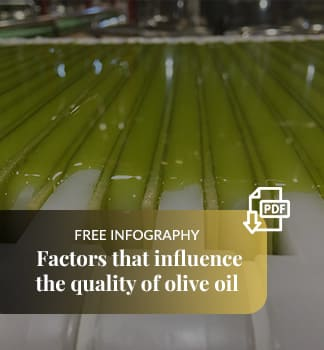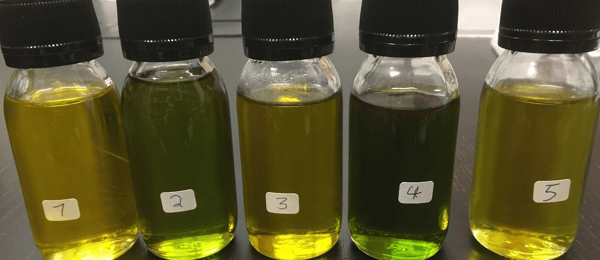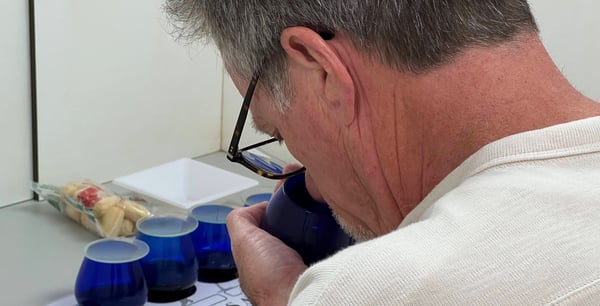The sensory analysis of virgin olive oil is one of the great challenges of Spanish society.
Spain is the world's leading producer of olive oil. However, the lack of knowledge of the population regarding oil is high.
In several surveys the consumer has been asked if they know the differences between extra virgin olive oil, virgin olive oil and lampante. 70% of those surveyed do not know what the differences are.
We are therefore going to try to convey the importance of olive oil tasting, as well as explain what the tasting itself consists of.
First of all, we have to know that there is a classification regarding virgin olive oil. This classification would be:
- Extra Virgin Olive Oil
- Virgin Olive Oil
- Lampante Virgin Olive Oil
This means that there is no other classification for olive oil. An oil cannot be classified in any other way.
Why am I saying this? Because approximately 60% of what is sold in supermarkets is called Olive Oil, without surnames: neither extra virgin, nor virgin, nor lampante.
Once we know the terminology of the three categories of virgin olive oil, and we know what olive oil is, we can continue with our learning.
Obviously, all this is essential to know in order to pay a different price for each category. If I know that an extra virgin is the highest quality of virgin olive oil, I will pay more than for a virgin olive oil, since its category is superior. And, if I already know that a dry olive oil is a refined product, because I will pay much less than for a virgin or for an extra, which now I know corresponds to an olive juice without any type of chemical refining process.
It is here, at this point, when it is important to know about tasting, because one of the great differences between a virgin and an extra is in the smell and taste.
An extra virgin should evoke nature, grass, fruit, even flowers, depending on what variety of olive it is, but it will always remind us of a fresh or clean product.
A virgin, it may not remind me so much of nature, or of the countryside, or of fruit, but somehow it will also evoke food.
A dry olive oil, normally it will not smell like anything or taste like nothing to me. That is, as if it were water but with a denser texture.
We are going to learn a little about oil tasting, to find out what we want to pay for, and if we pay for what we want. Or if we are paying the same for things that have nothing to do with each other.
The tasting will be the only one that helps us identify which oil we are facing.
For the oil tasting, smell and taste will be used.
The first thing when I find myself before a sample of virgin olive oil, is the FRUIT and later I will work the BITTER AND THE SPICY.
What is fruity in a virgin olive oil?
Fruity means amount of aroma. When I smell the oil, I will be able to work and differentiate three levels of fruity: light, medium or intense.
Bitter means how bitter the oil is once I have tasted it in the mouth.
Spicy means how spicy the oil is once it has been tasted in the mouth.
These three points would be the positive parameters in virgin olive oil.
How do I taste a virgin olive oil?
Utensils:
- Oil
- A glass or cup
- A lid for the glass or cup
First of all, you must have a container, such as a glass, or a wine glass, ideally with a rounded shape at the base, since, unlike wine, the oil to taste it is good if it is heated with your hands a little, transmitting the temperature of your body, so that it helps us to release volatiles and to identify aromas (official tasting 28ºC + -2ºC)
For official tastings we have official tasting glasses, blue in color and effectively rounded at the base. They are comfortable and help in sensory analysis.
You have to pour an amount of oil that exceeds the base of your glass or glass one centimeter at most (official tasting 15 cl).
Once the oil is added, cover it.
Now you have to be able to concentrate and focus on the show in front of you, that is, neither stand in front of the TV nor with a group of people watching you ... you have to be relaxed and concentrated.
Once you have the oil in your glass and you have it covered, you take it from the bottom and heat it, with the glass covered (official tasting, special heaters are used)
After about a minute, you open your glass and breathe in the smell that comes out of the glass. You take one or two breaths and cover it up again. Here you can see if it gives you those memories we were talking about of nature, countryside, fruit ... or if you notice different strange aromas such as vinegary, sour, cooked, rancid, rust ...
Later, he goes on to taste the oil in the mouth and to work on the bitter and spicy.
Bitter and spicy are related to the amount of antioxidants, vitamins, healthy components of olive oil. That a bitter and pungent oil is good, it is a symptom of healthy olive harvesting. Now, you have to try not to spice or bitter excessively so that it is not aggressive or unpleasant, but remember that bitterness and itching are positive attributes when tasting virgin olive oil.
With these three analyzes of fruity, bitter and spicy, I will be able to classify my oil sample.
If it is clean, if it smells of nature to me, if when I taste it it is pleasant and I do not notice anything dirty, I will be facing an extra virgin.
If when tasting it or smelling it I notice anomalous odors and different from nature, it is easy that you are before a virgin olive oil.
If, on the other hand, the sample is very unpleasant to me, with a high alteration or defect and where I feel rejection, it is possibly a lampante virgin olive oil, and remember that in the standard I have told you before that lampante virgin olive oil it cannot be consumed.
This is the basic and fundamental thing that I can explain to you in an article or book. Now you have to put yourself into practice and do it. Train and have good references to be able to assess.
As many of you may be thinking, a lot or a little are undefined terms where for what one is a lot for the other is little, with which this is regulated in some way, through what are the Tasting Panels.
 ESAO Independent Tasting Panel. ESAO image bank
ESAO Independent Tasting Panel. ESAO image bank
What is a tasting panel?
A tasting panel is a group of 10, 15 people (official panels need a minimum of 8 people) trained, and who meet weekly to test and classify virgin olive oils. The panel is the one who says if an oil is classified as extra virgin, virgin or lampante.
We use sheets in the panel called profile sheets, which are the same for all tasting panels.
In these leaves the fruity, bitter and spicy is established, with a line each, and each line symbolizes a score where the beginning of the line is zero and at the end of the line is 10. If we mark a fruity for example in the first third of the line we will be facing a light fruity, if we mark the second third of the line it will be a medium fruity and if we mark the last third it will be an intense fruity.
We will do the same procedure for the bitter and spicy. Although I have to say that if the bitter and / or spicy we put in the third third of the line, that is, we mark it between 6 and 9 points, we could say that we must be careful if it is too spicy or bitter for the consumer.
This would be what we will call the olive oil tasting or sensory analysis.
To finally classify a virgin olive oil into extra, virgin or lampante, a physicochemical analysis will also be needed, but this analysis is much simpler since it will be performed in a laboratory and will come out with some parameters, where depending on the score it will be pigeonholed in one or another category. The physicochemical analytics have very wide ranges to change categories, with which it is easy for many to enter as extras, being for the sensory analysis virgins.
However, in sensory analytics or tastings, when there is a minimum defect we change the category.
If we get to know how it is tasted and we understand a little about virgin olive oils, we will know better how to buy and, above all, we will pay the appropriate amount for what category we want. If we do not know anything about tasting and do not distinguish some qualities from others, we will always be sold to the one who invests the most in advertising regardless of quality, right?
There are countless virgin and extra wonderful olive oils, with incredible characteristics and palatability, and, above all, we are talking about one of the healthiest fats in the world. To this we add that Spain is the first producer. So, let's become aware and get a little closer to this pillar of the well-cared and adored Mediterranean diet.
Let's use virgin olive oil and, above all, let's train ourselves in this very Spanish and generous product that nature gives us.
If you want to enter the world of virgin olive oil tasting, we recommend that you consult the Olive Oil Sommelier Certification.
.png)





